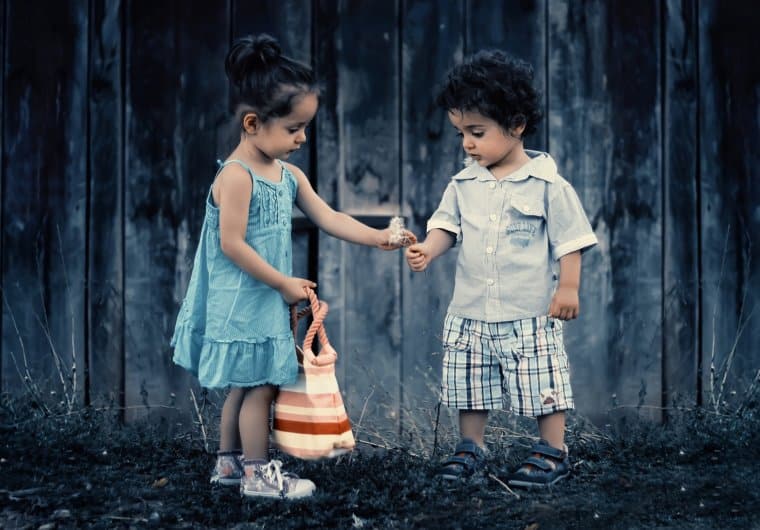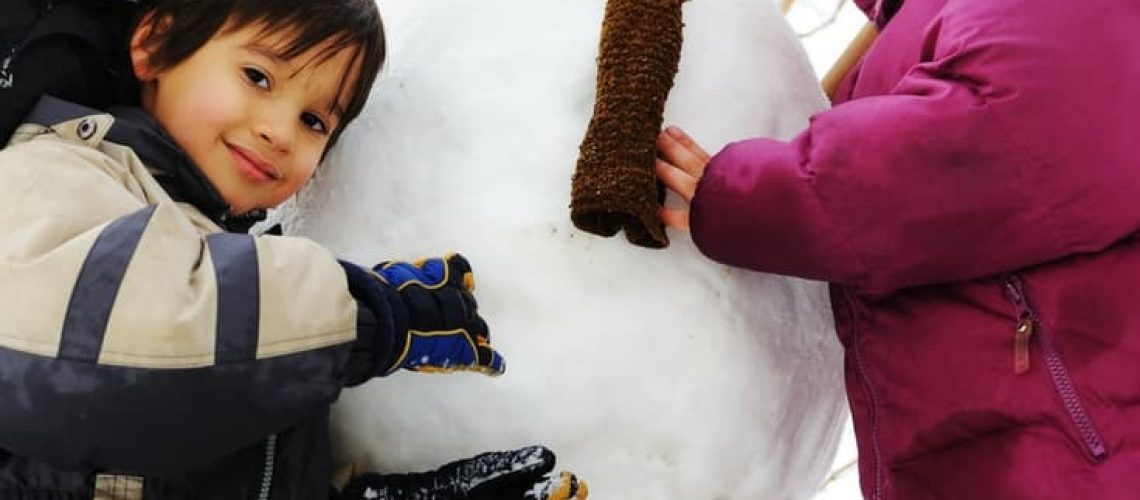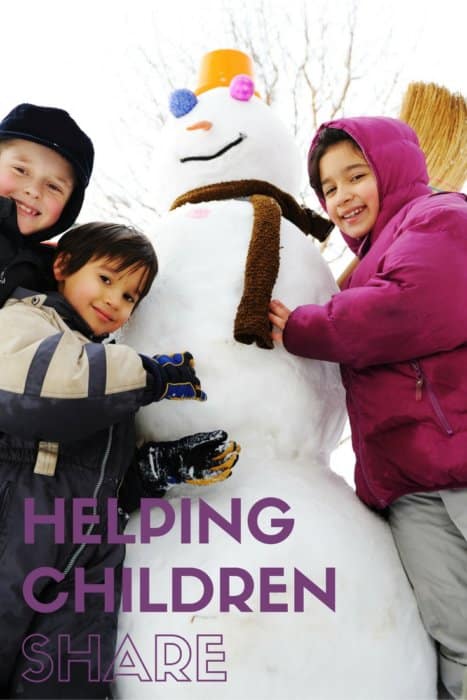“Mine!” screeches my 2-year-old and I turn round to find him holding on tight to a Tonka truck. His 7-year-old brother has the other end and is pouting back, “No it’s not.” Undeterred my youngest tightens his grip and roars loudly. Then they are screaming in each other’s faces, tussling over the toy.
At moments like this I often feel a wave of embarrassment where I’m vaguely hoping that surely this time, one of my children will respond with the maturity of a well-balanced adult and gracefully give his sibling the toy. And as hope of that quickly fades I feel an urge to fall into the pit with them and snatch the toy sneering something like, “If you can’t play nicely then neither of you can have it!”
In my endless quest to parent more compassionately, I’ve stumbled across insights that have given me far more realistic expectations about sharing. They offer a deep understanding of the big feelings that can get kicked up around sharing. And in my better parenting moments these ideas even let me embrace squabbles over toys as opportunities to build connection.
How we think about sharing
One of my favorite pieces of writing on sharing comes from Heather Shumaker in her wonderful book It’s Okay Not to Share.
She points out how as adults we naturally take turns rather than share on demand. You’d likely feel really cross if your friend grabbed the book you were reading and said, “I want it now, you’ve had it a really long time,” you’d expect her to wait until you’d finished. And this concept of waiting until “you’re all done” works incredibly well for children too. It avoids the pitfalls of sharing that interrupt children’s play and encourage false generosity.
“Sure, you can have it when she’s finished with it,” can be a relief to everyone. Children get to enjoy a toy for as long as they are interested in it which allows them to play more deeply and feel relaxed. It also opens up their sense of wanting to share by allowing them to choose when to pass it on and they then get to enjoy the feelings of being generous. Even very young children easily pick up on this and quickly come to adopt it in their own play. I’ll often hear my two year old say, “you have it when me finished.”
Younger children can easily be guided. “You can have it when Jack is finished. Jack can you let Lilly know when you’ve finished?” or “Are you finished with your turn? Oh, she’s not done yet.” And older children can be encouraged to say, “I’m not done yet, you can have it when I’m finished.” Once older children get used to this, it helps them handle turn taking without needing adult support.
Of course there are also plenty of times when waiting for his turn is just too much for my two-year-old. Like with the Tonka truck. Then he needs more help.
Children love to share
It’s really helpful to remind ourselves that children are always doing their best; that they want to fit in, be part of their family, and get on with their brothers and sisters. So when things are tough and their behavior flares, there are reasons for this. It’s good to notice that even very young children are quite capable of sharing toys and taking turns when they’re feeling good and connected. Sharing and turn taking seems to be an innate part of our social nature.
Listening to feelings
 We can see that when children are struggling to share, it’s a big red flag that they have feelings getting in the way, blocking their natural instinct to give and take. Attachment theory research shows us that children depend on a sense of connection to the adults around them. Connection is vital. When that sense of connection breaks, feelings flood their mind making it hard to think well. This lost sense of connection might come from feeling disconnected from their caregiver in the past few hours or because something has happened to remind them of stored hurt feelings inside which are now bubbling to the surface. (It’s also possible that physical issues like thirst, hunger, allergies, or digestive problems are behind their inner tension.) Either way, they need us to connect with them. It helps to move in close and listen to their upset. It might be tempting to try to fix things, to make them feel better, to try to reason with them, or to get them thinking rationally and naming their feelings. But taking the time to slow down and simply be with them as they shed emotional tension is, in the long run, more helpful. Allowing a child to experience their emotions helps them process those feelings on a physical level, and this seems to be deeply healing.
We can see that when children are struggling to share, it’s a big red flag that they have feelings getting in the way, blocking their natural instinct to give and take. Attachment theory research shows us that children depend on a sense of connection to the adults around them. Connection is vital. When that sense of connection breaks, feelings flood their mind making it hard to think well. This lost sense of connection might come from feeling disconnected from their caregiver in the past few hours or because something has happened to remind them of stored hurt feelings inside which are now bubbling to the surface. (It’s also possible that physical issues like thirst, hunger, allergies, or digestive problems are behind their inner tension.) Either way, they need us to connect with them. It helps to move in close and listen to their upset. It might be tempting to try to fix things, to make them feel better, to try to reason with them, or to get them thinking rationally and naming their feelings. But taking the time to slow down and simply be with them as they shed emotional tension is, in the long run, more helpful. Allowing a child to experience their emotions helps them process those feelings on a physical level, and this seems to be deeply healing.
When my 2-year-old was tugging at the Tonka truck screaming, “It’s mine!” I moved in and put my hand on his and mustered up as warm a vice as I could, ”Yep it’s yours and your brother is playing with it now. I’ll wait with you till he’s finished with it.” He kept holding tightly to the truck and shouting, “No! No! No!” crossly. I just kept my hand on his and waited a little. Then I said again, “You can have it when he’s finished.” The anger gave way to tears and he let go of the toy and cuddled into me still crying. I didn’t try to stop the tears, I just listened, gently offering eye contact. Pretty soon his big brother offered the truck back to him and he happily took it.
A child who is struggling to wait for their turn is helped enormously when we listen to their feelings. It seems to clear out the backlog of tension that was getting in the way of having the patience to wait for their turn. Patty Wipfler, Founder of Hand in Hand Parenting and author of the book Listen: Five Simple Tools to Meet Your Everyday Parenting Challenges, calls the way we listen to children’s upsets “Staylistening.” She says that when a child begins to cry, storm, or tantrum, “it's constructive. It's your child’s way of getting rid of the tension that made her unreasonable in the first place. If you can stay close while she cries or storms, she will continue until she has regained her ability to listen, to be cooperative, and to make the best of the situation at hand.”
Listening to feelings also shifts our efforts away from “teaching” children to share and towards focusing on what’s stopping them from getting along well with each other. Targeting the cause of their behaviour rather than the surface level struggles.
“I’ll wait with you”
Other times a child might be helped just by having us wait with them. By staying close, we are offering ourselves and that tops up their vital need for connection.
Sometimes it’s useful to help a child think about what they might do whilst they are waiting e.g. “Would you like to do this puzzle whilst you are waiting?” Children who are used to this “waiting until the other child is finished with policy” get very good at finding other things to do, and will often be able to come up with ideas.
Adult ideals
But why do I feel embarrassed when my kids struggle with sharing? As adults we seem to have a lot vested in our children’s ability to share and take turns. And we ask a lot of them. We hope they might be able to share their favourite teddy, their treasured dump truck, or their bran new train set. Yet in all truth we ourselves might have some difficulty if our best friend asked if she could borrow our precious new leather handbag for the afternoon or our iPhone for the weekend.
So maybe, when I feel embarrassed about children’s sharing squabbles, it’s my adult eyes longing for some utopian ideal through my children where everything is shared freely. But as Shumaker points out, “keeping a toy when another child wants it is not the making of a selfish child, but simply a busy one……waiting for a turn teaches great lessons in delayed gratification…..turn taking empowers kids and helps teach courtesy, awareness, and spontaneous generosity.” When a child has some control over giving another child a turn with a toy they are truly sharing. As adults we get quite confused around sharing because, “We mix up right to property (“it’s mine!”) with the right to play (the child is busy)….. But turn taking is not really about property at all. It’s about learning social awareness and protecting precious playtime.”
Six More Strategies To Help With Sharing
“What are we going to do here?”
From a very young age it endlessly impresses me how well children can solve problems around sharing themselves. Simply getting close and gently saying something like, “Mmm, this is a bit tricky: Tom wants to play with the doll and so does Abby. Can either of you figure out how we’re going to solve this?” Very often children are able to come up with their own solutions. Sometimes it helps if you offer a suggestion, “Could you take turns?” and even if your idea is rejected, it has a way of opening up other possibilities.
“It’s mine” game
Laughter is a powerful way of releasing emotional tension and a good game of “It's Mine” can help children laugh deeply about sharing. How to play: make sure you have a good supply of small pillows or cushions. Lightly insist that one pillow is yours: “It’s mine! and I’m not going to share it!” goofily huffing and puffing cuddling a pillow tight. I have yet to find a child under the age of 10 that doesn’t find it really funny. Most will dive in and grab your pillow which is good place to have a tussle over the pillow following any laughs that come up.
Hand puppet squabbles
In a similar vein, another strategy is to play goofy games with soft toys or hand puppets (or simply your hand as a puppet).
Teddy, “this is my ball and no-one else can have it ever.”
Doll, “you can’t keep it all to yourself you have to share.”
Teddy, “well I’m not going to so there!” etc.
Any laughter or giggles that you get are powerful ways for children to relieve their lighter feelings around sharing. Often kids will ask you to play these games again and again, they intuitively know how helpful they are.
Things not for sharing
As adults we regularly don’t let our children use some of our possessions, maybe our phones or treasured jewelry. Asking a child to put away any toys that they don’t want to share before a play date can ease tensions.
Modeling sharing
Modeling is powerful. Pam Leo in her book Connected Parenting suggests having a box of toys that are “our” toys which we share when other children come round to play.
Writing down whose turn is next
My local preschool use
Meet the Instructor
 Rachel Schofield, a Hand in Hand Instructor with 10+ years experience who can show you how to help your child share and build an utterly delightful relationship. Join her in a Hand in Hand Parenting Starter Class
Rachel Schofield, a Hand in Hand Instructor with 10+ years experience who can show you how to help your child share and build an utterly delightful relationship. Join her in a Hand in Hand Parenting Starter Class
s lists to help children take turns. They write down the name of a child who wants a go at some activity and children can go off and play something else knowing that they’ll get called when it’s their turn. At home I write notes on Post-its as reminders. For example both my kids like to collect the eggs from our chickens so we put a note up to remind us whose turn it is next time.

 By
By